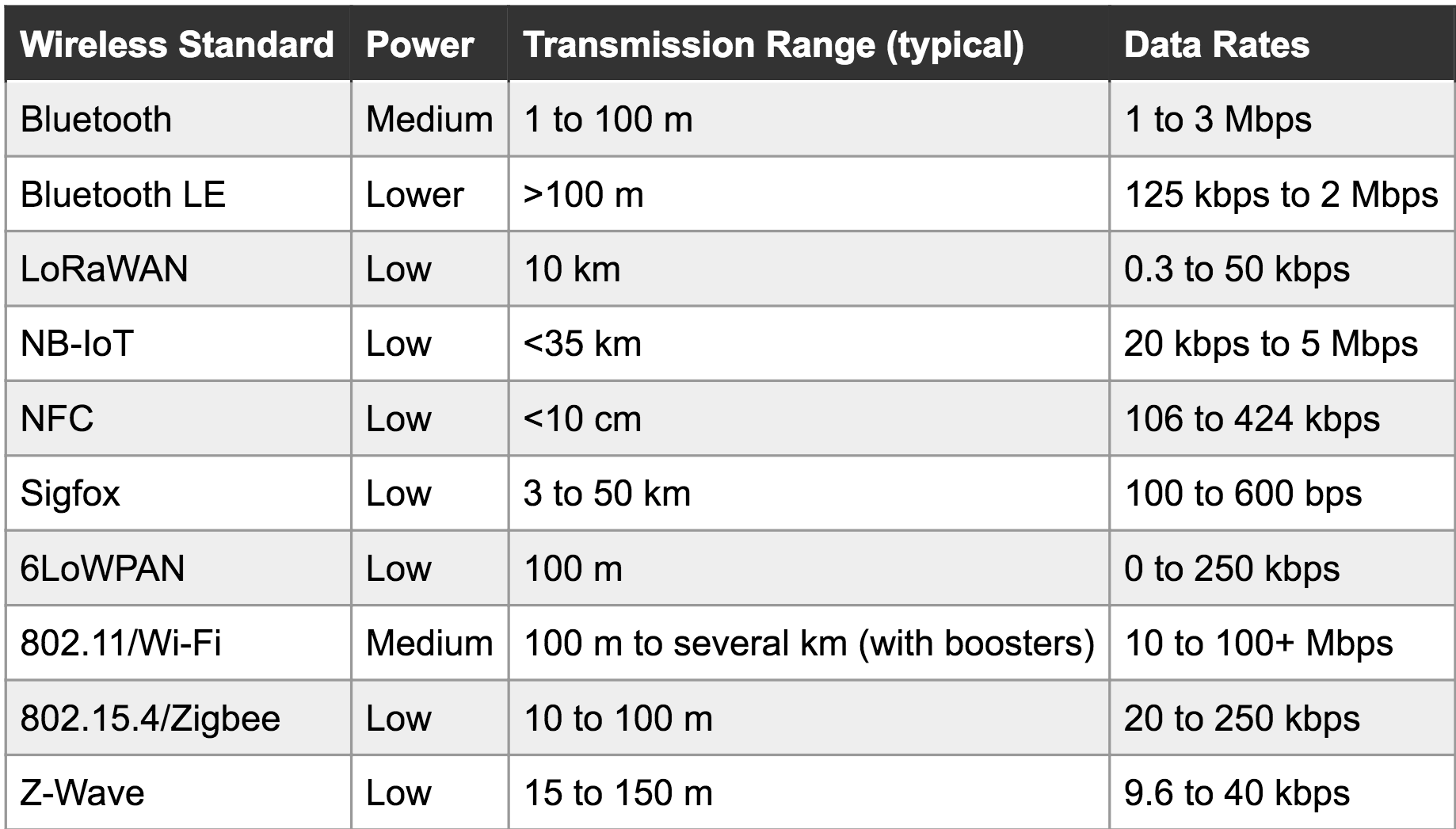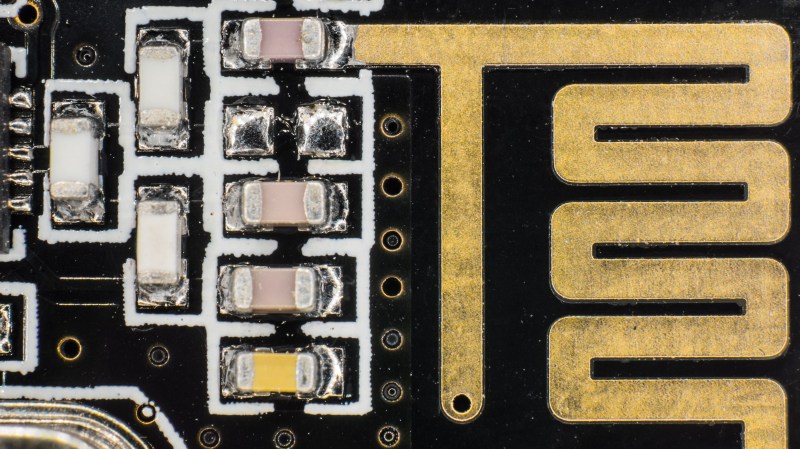Back in the early days of Arduino proliferation (and before you ask, yes we realize there was a time before that too), wireless was a strange and foreign beast. IR communication was definitely a thing. And if you had the funds there was this cool technology called ZigBee that was available, often in funny blue house-shaped XBee boards. With even more funds and a stomach for AT commands you could even bolt on a 2G cell radio for unlimited range. WiFi existed too, but connecting it to a hobbyist ecosystem of boards was a little hairier (though maybe not for our readership).
But as cell phones pushed demand for low power wireless forward and the progression of what would become the Internet of marking Terms (the IoT, of course) began, a proliferation of options appeared for wireless communication. Earlier this week we came across a great primer on some of the major wireless technologies which was put together by Digikey earlier in the year. Let’s not bury the lede. This table is the crux of the piece:

There are some neat entries here that are a little less common (and our old friend, the oft-maligned and never market-penetrating ZigBee). It’s actually even missing some entries. Let’s break it down:
- Extremely short range: Just NFC. Very useful for transferring small amount of sensitive information slowly, or things with high location-relevance (like between phones that are touching).
- Short range: BLE, Zigbee, Z-Wave, etc. Handy for so-called Personal Area Networks and home-scale systems.
- Medium/long range: Wifi, Bluetooth, Zigbee, Z-Wave, LoRaWAN: Sometimes stretching for a kilometer or more in open spaces. Useful for everything from emitting tweets to stitching together a mesh network across a forrest, as long as there are enough nodes. Some of these are also useful at shorter range.
- Very Long range/rangeless: Sigfox, NB-IoT, LTE Category-0. Connect anywhere, usually with some sort of subscription for network access. Rangeless in the sense that range is so long you use infrastructure instead of hooking a radio up to a Raspberry Pi under your desk. Though LoRa can be a fun exception to that.
You’re unlikely to go from zero to custom wireless solution without getting down into the mud with the available dev boards for a few different common protocols, but which ones? The landscape has changed so rapidly over the years, it’s easy to get stuck in one comfortable technology and miss the appearance of the next big thing (like how LoRaWAN is becoming new cool kid these days). This guide is a good overview to help catch you up and help decide which dev kits are worth a further look. But of course we still want to hear from you below about your favorite wireless gems — past, present, and future — that didn’t make it into the list (we’re looking at you 433 MHz).
















PANs never seem to have taken off, home automation notwithstanding, and even that has had growing pains.
So which is the right one? Samsung Hub, Smart wilink, sengled bridges? Argh!
Obligatory.
https://xkcd.com/927/
If that’s the one about “standards”, just say so, so we don’t have to bother looking. It likely is though. One of their few smug, facile comics to actually say anything useful.
It’s the new rick rolling.
What? You don’t recognize the comic by number?!?!
I walk into a room, say “https://xkcd.com/927/” and it leaves them in stitches!
Picture of a NRF24l01, but no mention of Nordic propriatery standard? :)
The nRF24L01 protocol is called Enhanced Shockburst, btw.
Nor of ANT!
The article says that BLE is short range and Bluetooth is medium range, but the table shows BLE having a range greater than than that of Bluetooth. Am I misreading it?
No you caught it right. BLE 5 is an interesting beast. In its highest bandwidth configuration the range is relatively short. But in the lowest bandwidth longest range mode it can got for kilometers (seriously!), though finding radios that support those modes seems a little less common.
The only radio that I know of, and that is readily available, is that of the Nordic nRF52 chips.
You can actually use a nRF52840 board with USB as a USB Bluetooth stick, using Zephyr Project.
Unfortunately, even newer Phones with BLE5 don’t support the long range modes.
Would’ve been nice for Walkie-Talkie mode. And for using them in your home automation.
I figured the PSoC6 would support it too, but it looks like it only supports the 2Mbps feature of BLE5.
Interesting! I didn’t realize the nRF52s supposed the long range stuff. I think some TI parts might too? I’m also disappointed (no?) phones seem to support it. I’d also love to see a long range walkie talkie or chat tool that didn’t require extra hardware.
The Silicon Labs EFR32BG13, EFR32MG13, BGM13 are BKE 5 compatible and pretty cool to use ( I like their stack). There are also able to do BLE mesh but I never tried…
very interesting, I did not know about that. Obviously for many simple applications some very low bandwidth would suffice (e.g. sending an occasional byte over serial to turn something on or off).
What is completely missing is the power consumption of these radios. Wifi is very different from something like Bluetooth/BLE or ZigBee, even though they could cover similar ranges and offer similar bandwidth (with the commonly available cheap modules Wifi tends to be closer to 3-5Mbps than the 100+).
Wifi in practice rarely gets more than 1/10th the bandwidth because of interference from other networks and devices. It’s not about the cheapness of the module, but about the fact that everyone’s got a wifi radio in their pockets today.
Table could be better. I see a list of protocols, which may or may not be tied to a frequency or have one specified, and the frequency being kinda important as regards power consumption, range and cohabitation with other services. I believe LoRa can be used on many frequencies, and 802.11 WLAN is of course on both 2.4 and 5 ghz
I would have liked a bit more information such as power consumption, open or proprietary and cost. For example, I use wifi for most communications because the cost is very low with the bonus that bandwidth is high. It uses a lot of power and so is not good for battery powered devices unless they sleep a lot. If there were a suitable low cost, low power, reliable, open standard with,say, 1Mbs or more bandwidth I would use that but such standards seem to be proprietary and/or significantly more expensive than Wifi.
My wireless internet access point is 8 miles away and uses 5GHz wifi. I get 30 Mbps down and 5 Mbps up
LoRaWAN is a bit of a hot mess, since anyone can set up network nodes and it’s over free ISM bands. Great, if you’re the only guy in town doing it, not so great when there’s other peoples’ networks to deal with. It’s very simple to jam it, and the network congests extremely rapidly when you have to start re-sending packages and verifying they actually got through.
When the base station is sending data towards the devices, it blocks it from hearing any of the devices on the same channels, so sending back an ACK packet to the device slashes the network bandwidth down tremendously.
Sounds like UDP, and lots of error correction needed.
These radios are designed for devices which send one data packet every few minutes to a few hours. A single device should only transmit 1% of the time over a day on the ISM band, which means you actually have very little capacity. 864 seconds x 60 bits/s : 8 bits per byte = 6.48 MB per day. You can’t afford a whole lot of error correction while still transmitting useful data.
LoRa uses a sort of spread-spectrum frequency hopping technology to get around interference, but otherwise it’s not very robust.
In comparison, SigFox has a limit of 12 bytes per packet, and it re-transmits it three times at three different frequency ranges on a random frequency to make sure some of the base stations pick up the packet. If none do, the packet is lost. Again, no aknowledgements are sent because sending data from the network to the device has a huge bandwidth penalty on the network.
I seem someone forgot the HAM radiowaves. Let the games begin…